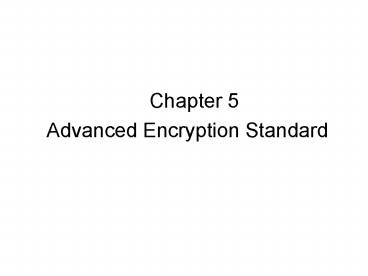Advanced Encryption Standard - PowerPoint PPT Presentation
1 / 18
Title:
Advanced Encryption Standard
Description:
Chapter 5 Advanced Encryption Standard – PowerPoint PPT presentation
Number of Views:179
Avg rating:3.0/5.0
Title: Advanced Encryption Standard
1
- Chapter 5
- Advanced Encryption Standard
2
Origins
- clear a replacement for DES was needed
- have theoretical attacks that can break it
- have demonstrated exhaustive key search attacks
- can use Triple-DES pretty safe
- but slow, small blocks
- issued call for ciphers in 97
- 15 candidates accepted in Jun 98
- 5 were short-listed in Aug-99
- AES selected in Oct-2000
- issued as FIPS PUB 197 standard in Nov-2001
3
AES Requirements
- private key symmetric block cipher
- 128-bit data, 128/192/256-bit keys
- stronger faster than Triple-DES
- active life of 20-30 years ( archival use)
- provide full specification design details
- both C Java implementations
- NIST have released all submissions unclassified
analyses
4
AES Evaluation Criteria
- initial criteria (15 to 5)
- security effort to practically cryptanalyse
- cost computational, high-speed applications
- algorithm implementation characteristics
- Flexibility, simplicity, maintainability
- final criteria
- general security
- software hardware implementation ease
- implementation attacks
- flexibility (in changing en/decrypt, keying,
rounds, other factors)
5
AES Shortlist
- after testing and evaluation, shortlist in
Aug-99 - MARS (IBM) - complex, fast, high security margin
- RC6 (USA) - v. simple, v. fast, low security
margin - Rijndael (Belgium) - clean, fast, good security
margin - Serpent (Euro) - slow, clean, v. high security
margin - Twofish (USA) - complex, v. fast, high security
margin - then subject to further analysis comment
- All were thought to be good came down to best
balance of attributes to meet criteria. - Note mix of commercial (MARS, RC6, Twofish)
verses academic (Rijndael, Serpent) proposals
6
The AES Cipher
- designed by Rijmen-Daemen in Belgium
- has 128/192/256 bit keys, 128 bit data
- an iterative rather than feistel cipher
- treats data in 4 groups of 4 bytes
- operates an entire block in every round
- rather than feistel (operate on halves at a time)
- designed to be
- resistant against known attacks
- speed and code compactness on many CPUs
- design simplicity
7
AES
- processes data as 4 groups of 4 bytes (state)
- has 9/11/13 rounds in which state undergoes
- byte substitution (1 S-box used on every byte)
- shift rows (permute bytes between groups/columns)
- mix columns (subs using matrix multiply of
groups) - add round key (XOR state with key material)
- initial XOR key material incomplete last round
- all operations can be combined into XOR and table
lookups - hence very fast efficient
8
Rijndael
9
Byte Substitution
- a simple substitution of each byte
- uses one table of 16x16 bytes containing a
permutation of all 256 8-bit values - each byte of state is replaced by byte in row
(left 4-bits) column (right 4-bits) - eg. byte 95 is replaced by row 9 col 5 byte
- which is the value 2A
- S-box is constructed using a defined
transformation of the values in GF(28) - designed to be resistant to all known attacks
10
Shift Rows
- a circular byte shift in each row
- 1st row is unchanged
- 2nd row does 1 byte circular shift to left
- 3rd row does 2 byte circular shift to left
- 4th row does 3 byte circular shift to left
- decrypt does shifts to right
- since state is processed by columns, this step
permutes bytes between the columns
11
Mix Columns
- each column is processed separately
- each byte is replaced by a value dependent on all
4 bytes in the column - effectively a matrix multiplication in GF(28)
using prime poly m(x) x8x4x3x1
12
Add Round Key
- XOR state with 128-bits of the round key
- again processed by column (though effectively a
series of byte operations) - inverse for decryption is identical since XOR is
own inverse, just with correct round key - designed to be as simple as possible
13
AES Round
14
AES Key Expansion
- takes 128-bit (16-byte) key and expands into
array of 44/52/60 32-bit words - start by copying key into first 4 words
- then loop creating words that depend on values in
previous 4 places back - in 3 of 4 cases just XOR these together
- every 4th has S-box rotate XOR constant of
previous before XOR together - designed to resist known attacks
15
AES Decryption
- AES decryption is not identical to encryption
since steps done in reverse - but can define an equivalent inverse cipher with
steps as for encryption - but using inverses of each step
- with a different key schedule
- works since result is unchanged when
- swap byte substitution shift rows
- swap mix columns add (tweaked) round key
16
Implementation Aspects
- can efficiently implement on 8-bit CPU
- byte substitution works on bytes using a table of
256 entries - shift rows is simple byte shifting
- add round key works on byte XORs
- mix columns requires matrix multiply in GF(28)
which works on byte values, can be simplified to
use a table lookup
17
Implementation Aspects
- can efficiently implement on 32-bit CPU
- redefine steps to use 32-bit words
- can pre-compute 4 tables of 256-words
- then each column in each round can be computed
using 4 table lookups 4 XORs - at a cost of 16Kb to store tables
- designers believe this very efficient
implementation was a key factor in its selection
as the AES cipher
18
Summary
- have considered
- the AES selection process
- the details of Rijndael the AES cipher
- looked at the steps in each round
- the key expansion
- implementation aspects































